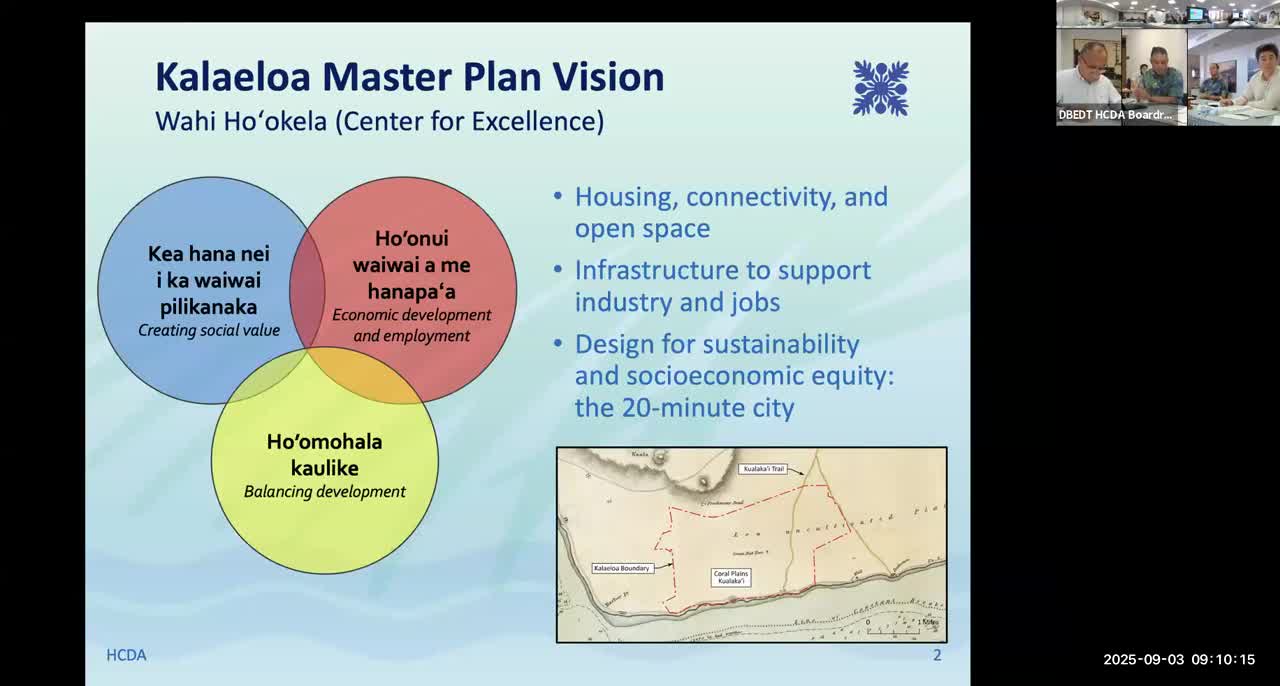Kailua Community Planning Incorporates Cultural History and New Development Typologies
September 04, 2025 | Hawaiʻi Community Development Authority, Executive , Hawaii
This article was created by AI summarizing key points discussed. AI makes mistakes, so for full details and context, please refer to the video of the full meeting. Please report any errors so we can fix them. Report an error »

The Hawaii Community Development Authority (HCDA) is moving forward with a transformative plan for Kalaeloa, aiming to create a sustainable community that prioritizes accessibility and cultural heritage. During a recent presentation hearing on September 4, 2025, officials outlined key strategies to enhance the area’s livability and resource conservation.
One of the central themes of the plan is to ensure that residents can access essential services—such as retail, schools, and employment—within a 20-minute walk. For broader regional activities, including cultural and medical services, the plan emphasizes connectivity through biking and transit options. This approach is designed to foster a more sustainable lifestyle while reducing energy consumption.
The HCDA is also focusing on integrating the rich history of the Kalaeloa area into the development framework. Efforts are underway to highlight historical landmarks, such as the Balakai Trail and Kailua Heritage Park, which reflect the area's cultural significance and military history.
A significant change proposed in the planning rules is the introduction of floor area ratios (FAR) to regulate building mass. This new urbanism approach categorizes land use into five typologies, ranging from rural (T2) to urban centers (T5). Each typology has specific height and usage regulations, allowing for a mix of residential, commercial, and industrial developments. For instance, T2 allows for buildings up to 24 feet, while T5 permits heights of 90 feet, accommodating more intense urban development.
The HCDA's vision includes creating vibrant mixed-use spaces, particularly along Main Street, where ground-floor commercial activities can thrive alongside residential units above. This strategy aims to enhance community interaction and economic vitality.
As the HCDA continues to refine the Kalaeloa plan, the focus remains on balancing development with sustainability and cultural preservation. The next steps will involve further community engagement and detailed planning to ensure that the vision aligns with the needs and aspirations of local residents.
One of the central themes of the plan is to ensure that residents can access essential services—such as retail, schools, and employment—within a 20-minute walk. For broader regional activities, including cultural and medical services, the plan emphasizes connectivity through biking and transit options. This approach is designed to foster a more sustainable lifestyle while reducing energy consumption.
The HCDA is also focusing on integrating the rich history of the Kalaeloa area into the development framework. Efforts are underway to highlight historical landmarks, such as the Balakai Trail and Kailua Heritage Park, which reflect the area's cultural significance and military history.
A significant change proposed in the planning rules is the introduction of floor area ratios (FAR) to regulate building mass. This new urbanism approach categorizes land use into five typologies, ranging from rural (T2) to urban centers (T5). Each typology has specific height and usage regulations, allowing for a mix of residential, commercial, and industrial developments. For instance, T2 allows for buildings up to 24 feet, while T5 permits heights of 90 feet, accommodating more intense urban development.
The HCDA's vision includes creating vibrant mixed-use spaces, particularly along Main Street, where ground-floor commercial activities can thrive alongside residential units above. This strategy aims to enhance community interaction and economic vitality.
As the HCDA continues to refine the Kalaeloa plan, the focus remains on balancing development with sustainability and cultural preservation. The next steps will involve further community engagement and detailed planning to ensure that the vision aligns with the needs and aspirations of local residents.
View full meeting
This article is based on a recent meeting—watch the full video and explore the complete transcript for deeper insights into the discussion.
View full meeting
